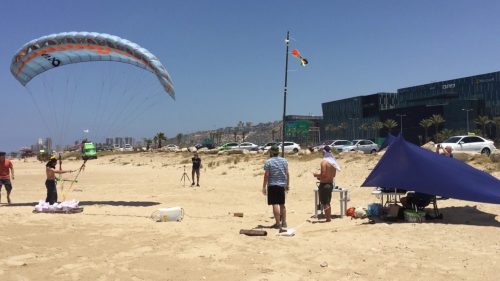A group of students from the Faculty of Aeronautics and Space Engineering at the Technion developed an autonomous parachute supply system in disaster areas.

PANDA, or in its full name "common paragliding parachute for dropping supplies in disaster areas", is a system that carries cargo for specific ground purposes. The system is dropped from a medium or heavy transport aircraft and navigates its way using a flight computer, two servo motors, a GPS system, batteries and various gauges.
"In disaster areas, essential infrastructures such as roads and railways leading to the place of impact are also usually damaged, so alternative means of transportation are necessary," explains Prof. Benny Landkoff, project leader. "Dropping supplies from the air is an accepted method, but the traditional parachute, which is performed with a circular parachute that cannot be controlled after it is dropped, requires the pilot to drop the cargo from a relatively low height - otherwise the parachute may drift away in the wind. In addition to the risk that sometimes exists when dropping from a low height, the range of error is still very large, and sometimes the load falls in the sea or on a mountain, hundreds of meters from the desired point. Due to these limitations, parachutes were developed that are remotely controlled and even slow down their fall before the cargo hits the ground."
During last year, the students conducted ground experiments to collect information for simulations of dropping a parachute from a height of several kilometers, and succeeded in landing a load of about 1000 kg less than a hundred meters from the target.
The current student project was conducted in collaboration with Afco (APCO Aviation) - a company for aviation products - and the experiments and development were carried out on the demonstration parachute donated by the company. This is a product made of a unique synthetic fabric, characterized by "zero porosity" and similar in shape to a paraglider. From AFCO's point of view, the project aims to improve its existing chute. The pre-defined task - dropping a load weighing a ton from a height of 3 to 7.6 kilometers, with a margin of error (the location of the fall on the ground) not exceeding 100 meters - was crowned with success. The development process included simulations and analyzes of the parachute, development of improvements and field experiments such as the one you can see in the attached image.
The student members of the group are: Nachum Eisen, Gilad Gottlieb, Amir Bidni, Avihai Ben Haim, Tzachi Kalderon, Amir Yanai, Daniel Potshnikov, Gal Rosenthal and Michal Vahab.

2 תגובות
Not long from now, Amazon will take care of sending supplies to soldiers in security areas as well.
And under fire.
The military security application is no less important.
The problem appeared a lot in the second Lebanon and more than once the fighters were not able to reach the supply. In addition to this, the need to parachute from a low altitude has a great impact on the risk of flight. I assume that if it is possible to parachute from a great height it will also be possible to parachute without flying right over the point